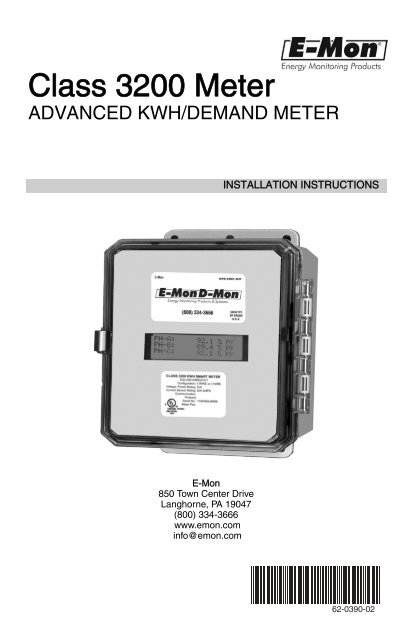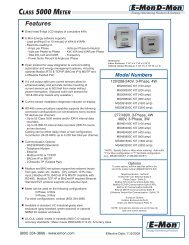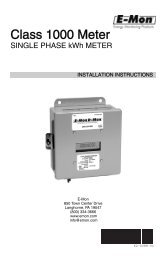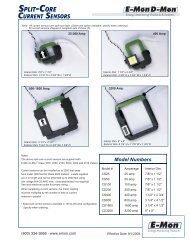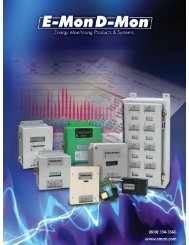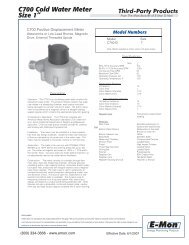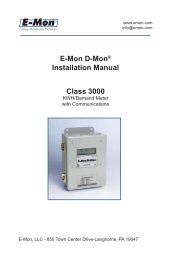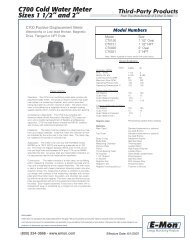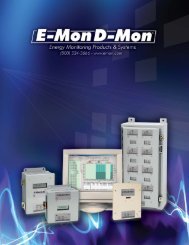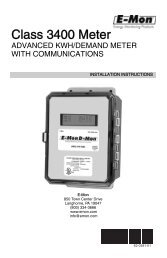You also want an ePaper? Increase the reach of your titles
YUMPU automatically turns print PDFs into web optimized ePapers that Google loves.
<strong>Class</strong> <strong>3200</strong> <strong>Meter</strong>ADVANCED KWH/DEMAND METERINSTALLATION INSTRUCTIONSE-<strong>Mon</strong>850 Town Center DriveLanghorne, PA 19047(800) 334-3666www.emon.cominfo@emon.com62-0390-02
CLASS <strong>3200</strong> METERDear Valued Customer,We are pleased that you chose to buy one of our products, and want you to be just aspleased with owning it. Before installing your new E-<strong>Mon</strong> product, please read theinformation on the following pages carefully.We believe that you will find the E-<strong>Mon</strong> D-<strong>Mon</strong> meters easy to install and to use formonitoring and evaluating your electrical usage.To be sure that you are 100% satisfied with your products, we provide toll-freetechnical and sales support <strong>Mon</strong>day through Friday, 8:00 am to 7:30 pm, EST:(800) 334-3666. You may also reach us via email at info@emon.com.If you have questions, we can handle them quickly and effectively with a telephone call.Please let us try to help you BEFORE you remove your meter. And to help us help you,we ask that you have all relevant information on hand when you call (model or partnumbers, nature of difficulty, etc.)Be sure to forward this manual to the owner after installation is complete, so that theymay use it as a reference guide when reading the E-<strong>Mon</strong> D-<strong>Mon</strong> meter.Thank you.62-0390-02 2
CLASS <strong>3200</strong> METER1.0 INTRODUCTIONThe E-<strong>Mon</strong> D-<strong>Mon</strong>® <strong>Class</strong> <strong>3200</strong> meter is a 3-element meter with communications. Thedevice is used to monitor electric power usage of individual loads after the utility meterand store kW and kVAR data for automatic meter reading. Installation must only beperformed by qualified personnel and in accordance with these instructions and allapplicable local and national electrical codes. E-<strong>Mon</strong> and its representatives assumeno responsibility for damages or injury resulting from the improper installation of thismeter.Verify the input voltage rating and configuration on the unit panel label to ensure that itis suitable for the intended electrical service. <strong>Class</strong> <strong>3200</strong> meters labeled for 120/208Vservice MUST NOT be installed on service feeds of 277/480 volts or 347/600 and viceversa.Verify that the <strong>Class</strong> <strong>3200</strong> meter’s current sensors are sized suitably for the load to bemonitored. Compare the color of the arrows on the current sensors to the chart belowto confirm the correct current sensor is being used.Sensor Arrow Color CodeBrownRedYellowBlackBlueWhite/BlackSensor Rating100 A200 A400 A800 A1600 A<strong>3200</strong> A62-0390-02 4
CLASS <strong>3200</strong> METERCAUTIONInternal circuit components are extremely sensitive to electrostatic discharge.Prior to handling or touching internal circuitry, discharge any static buildup onyour person. To discharge yourself, touch a grounded metal object such asconduit or an earth-grounded enclosure.WARNINGUse of this instrument, the E-<strong>Mon</strong> D-<strong>Mon</strong> <strong>Class</strong> <strong>3200</strong> meter, in a mannerinconsistent with this manual or not specified by the manufacturer in writing,can cause permanent damage to the unit and/or serious injury to the operator.The protection and safety features provided by this equipment may becomeimpaired or otherwise compromised.NOTE:If any trouble arises during the installation or functional verification operations,do not immediately remove the unit. Before removing the unit, contactE-<strong>Mon</strong>’s technical support and/or engineering department at (800) 334-3666.E-<strong>Mon</strong>’ s technical department will assist you in detailed troubleshooting ofthe <strong>Class</strong> <strong>3200</strong> meter installation and assist you in getting the unit operatingcorrectly.5 62-0390-02
CLASS <strong>3200</strong> METER2.0 INTERNAL ELECTRONIC ASSEMBLIESThe units are comprised of two major subassembly boards, the main power board andthe display board. Both circuit boards are mounted inside a UL Type 1 or Type 4Xenclosure.MAINPOWERBOARDDISPLAYBOARDM333072.1 Main Power BoardFig. 1. Internal Electronic Assemblies.Connections to this board include the MAIN Power Input and current sensors.TheMAIN Power Input terminals are positions one through four on the four position screwterminal block, TB1. These terminals are covered with a protective shield for safetypurposes. The current sensor assemblies interface to TB2, TB3 and TB4. Eachterminal block corresponds to an input voltage phase; care must be exercised toensure that each current sensor is connected to the correct terminal block. One threeterminal screw connector is provided for RS-485 communications.TB1POSITIONS1-4RS-485TB2, TB3,TB4Fig. 2. Main Power Board Connections.M3330862-0390-02 6
2.2 Display BoardCLASS <strong>3200</strong> METERThe display board connects to the main power board via a flex ribbon cable and theboard mounts on the inside of the housing door.The <strong>Class</strong> <strong>3200</strong> meter features a 4-line LCD display that indicates multiple meter datapoints.DOWNUPSELECTMENUM33279Fig. 3. Display Board.7 62-0390-02
CLASS <strong>3200</strong> METER3.0 METER TECHNICAL SPECIFICATIONSOrdering Information: Define brand, class, input voltage, amperage, protocol, andsensor type in the format A-BB-CCC-DDDD-E-FFF-GGG, whereA = Brand: E for E-<strong>Mon</strong>BB = designates <strong>Class</strong>: <strong>3200</strong> (32), 3400 (34), or 5000 (50) meterCCC = input voltage: (208, 480, 600, 120 volt for High Voltage)DDDD = current rating: (100, 200, 400, 800, 1600, <strong>3200</strong>, 25HV)E = enclosure: J = metal (type 1), R = non-metallic (type 4X), M = MMUFFF= protocol: RTU = Modbus, BAC = BACnet, EZ7 = proprietaryGGG = Sensors: KIT = split-core, SCS = solid-core, “blank” = none suppliedInput Voltage 3-wire (delta) Or 4-wire (wye)ConfigurationMains Voltage Input Up To 600 VAC RMS availableInput Power 6 VA maximum ratingCurrent Sensor Up To <strong>3200</strong> amps RMS AC availableRatingPower Factor 0.5 leading or laggingLine Frequency 50-60 Hz<strong>Meter</strong>ing Accuracy ANSI C12.20Temperature Range -20C to +50CRelative Humidity 0-95% non-condensingRangeAltitude2000 meters maximumVoltage Overload +25% continuously: +100% For 20 cyclesCurrent Sensor 100% for 1 minuteOverloadPollution Degree Degree 2 in accordance with IEC 664InstallationCategory III(Overvoltage)CategoryMeasurementCategoryEXAMPLE: E 32- 208 200 J RTU KITE-MONCLASS <strong>3200</strong> METERINPUT VOLTAGE (208V)CURRENT RATING (200A)ENCLOSURE (METAL - TYPE 1)PROTOCOL (MODBUS)SENSORS (SPLIT-CORE)Category IIIM3319162-0390-02 8
CLASS <strong>3200</strong> METER3.0 METER TECHNICAL SPECIFICATIONS(CONTINUED)Enclosure MaterialDisplay ReadoutStandard RangesRS-485 SerialCommunicationsCableRecommendedIn-Line FuseUL Type 1 or Type 4XLCD(4-Wire Wye) 208 VAC: 100, 200, 400, 800,1600, <strong>3200</strong> Amp(3-Wire Delta) 240 VAC: 100, 200, 400, 800,1600, <strong>3200</strong> Amp(4-Wire Wye) 480 VAC: 100, 200, 400, 800,1600, <strong>3200</strong> Amp(3-Wire Delta) 480 VAC: 100, 200, 400, 800,1600, <strong>3200</strong> Amp(4-Wire Wye) 600 VAC: 100, 200, 400, 800,1600, <strong>3200</strong> AmpCable:UL-listed/rated/3-conductor,300 VAC, strandedconductors, 22-26 AWG.Input/output Voltage: Ground-isolated +/-5.4VdcCable Connector:Screw terminal terminationCircuit Input Isolation: 5.3kVACMax Cable Distance: 4000 feetMax Network Nodes: 64 cabling nodes (includingmaster)Baud Rate: 9600, 19200, 38400, 76800Manufacturer:Mfg. Part No:Rating:LittlefuseKLDR.100100mA, time-delay, 600VACcartridge fuseBattery Cell: Description: Non-rechargeable cell used formemory retentionManufacturer:PanasonicMfg Part No:CR2032Working Voltage:3VdcCurrent Capacity225 mAHrElectrolyte:Manganese Dioxide Lithium9 62-0390-02
CLASS <strong>3200</strong> METER4.0 SAFETY LABEL DEFINITIONS ANDINFORMATIONThe <strong>3200</strong> meter may contain one or more of the following labels. Operator(s) shouldfamiliarize themselves with the meaning of each label to minimize risk.The presence of this label is a cautionary indicator identifying adanger risk. The manual should be consulted prior to proceeding.The presence of this label indicates an electrical shock hazard existsin the location or area where the label is placed. Prior to proceeding,the MAINS power must be disconnected and the manual consulted forsafety information.62-0390-02 10
5.0 PRECAUTIONARY AND SAFETYINFORMATIONCLASS <strong>3200</strong> METERCAUTIONInternal circuit card components are extremely sensitive to electrostaticdischarge. Be careful not to touch internal circuitry prior to discharging anystatic buildup on your person. To discharge yourself, touch a grounded metalobject such as conduit or an earth-grounded metal enclosure.WARNINGHigh voltages present on main PCB terminal block TB1 screw terminals. Riskof serious injury and/or electrical shock exists. Prior to performing any wiringoperations, review all contents of the user manual and de-energize the MAINSpower switch. Only qualified personnel should perform installation wiring.Installation wiring must comply with all local and national electrical codes.WARNINGFailure to ground the enclosure creates a possible shock hazard. Do notoperate the <strong>Class</strong> <strong>3200</strong> meter without a protective earth wire attached securelyto the PE terminal screw. After installing protective earth wiring, secure thescrew tightly (7in-lb torque.)WARNINGNEVER open front panel of unit while unit has MAINS power applied. Failure tocomply can increase the risk of serious injury and/or electrical shock.11 62-0390-02
6.2 Main Power Board Connections (continued)CLASS <strong>3200</strong> METER3. Wire Entry: One 3/4” conduit opening is located on the bottom of the CL<strong>3200</strong>enclosures. This opening is used for bringing in MAINS power and for currentsensor wiring. One 1/2” conduit opening on the top of the metal enclosureCL<strong>3200</strong> can be utilized as an interface for the low- voltage signals, pulse input,or RS-485 communications wiring to the unit. CL<strong>3200</strong> meters are available in anMMU (Multiple <strong>Meter</strong> Unit) enclosure that holds eight (8) meters. This enclosurecomes without knockouts and allows the user to choose entry points for the wiring.Any unused openings must be sealed with a UL rated plugging device or hubsuitable for the rating of the enclosure - such as NEMA 1 or 4X.4. Unit MAINS wiring:The four positions on terminal block TB1, located at the bottom left corner of themain power board, are clearly labeled Phase A, B, C, N (neutral). Earth GroundMUST be connected to the PCB mounting screw in the lower right corner.A. Connect the NEUTRAL wire to the appropriate terminal block position.Fig. 5. Terminal Block TB1, TB2, TB3, and TB4.NOTE:For 3-wire delta-type applications, do NOT connect the NEUTRAL wire.Remove the terminal block screw for this position.B. Earth GroundConnect the Earth Ground to the PCB mounting screw in lower right corner.C. External Switch Mechanism/In-Line Fuse InstallationTo ensure a safe installation, the <strong>Class</strong> <strong>3200</strong> meter requires an externalswitch mechanism, such as a circuit breaker, be installed on the meter’sMAINS input wiring. The switch mechanism must be installed in close proximityto the meter and easily reachable for the operator. This device mustalso be marked as the disconnecting device for the <strong>Class</strong> <strong>3200</strong> meter. 1/10Amp Slow Activation in line fuses (KLDR.100, UL listed, Littelfuse rated600V/100ma) must be installed for each conductor phase at the MAINS inputto the meter. The fuses must be labeled to indicate voltage and current ratingas well as element characteristics.The fuse element must be slow activatingtype.13 62-0390-02
CLASS <strong>3200</strong> METER6.2 Main Power Board Connections (continued)D. Connect the three AC main power wires (Phases A, B and C) to their respectivepositions as labeled on terminal block TB1. After all conductors are connectedto each of their respective terminal block positions and tightened to 7in-lb, verify that each terminal block screw is securely fastened by gently tuggingon each conductor. Verify that no conductor wires are frayed or shortingto adjacent terminal block positions.E. Turn ON the AC main power input. The meter display will light up and scrollthrough 6 displays. Each display is visible for 5 seconds. Display screens areas follows:Screen 1 - Total kilowatt-hours (kWh) consumedScreen 2 - Peak demand (kW) with date & time stampScreen 3 - Actual load (kW)Screen 4 - RMS AmpsScreen 5 - RMS Volts Phase to NeutralScreen 6 - RMS Volts Phase to PhaseScreen 7 - Power factor (PF) per phaseF. Verify the voltage readings on Screen 5 using an AC voltmeter. Typical readingsshown below are measured phase to neutral (L-N) for 4 wire and phaseto phase (L-L) for 3 wire. Readings should be +/- 10% of nominal.<strong>Meter</strong> Type Nominal Voltage Limits (+/- 10%)208V, 3ø, 4 Wire 120 VAC (L-N) 108 to 132 VAC480V, 3ø, 4 Wire 277 VAC (L-N) 249 to 305 VAC600V, 3ø, 4 Wire 347 VAC (L-N) 312 to 380 VAC240V, 3ø, 3 Wire 240 VAC (L-L) 216 to 264 VAC480V, 3ø, 3 Wire 480 VAC (L-L) 432 to 528 VACNOTE:<strong>Meter</strong>s are powered by phases A and B. The displayed voltages will be themeasured AC voltage between phases.62-0390-02 14
6.3 Phasing of Line VoltageCLASS <strong>3200</strong> METERThe 3-phase AC power input must be in proper phase sequence. If the sequence isincorrect or a phase is missing, there will be a message on the meter’s display: “PHSequence Error” or “PH Missing:. (Refer to the section on Line Voltage Diagnostics ifthis message is present.) When the line voltage is connected correctly, the meter’sdisplay will be blank (no message.)Wait for the 4-line meter display to scroll to the voltage display. Verify that the meterreads correct voltages on all three phases. Repeat Step 6.2.4F.Once the meter displays the correct line voltages and there are no error messages,you are ready to connect the current sensors to the meter. Before continuing with theinstallation, verify that the six screens display as follows:Screen 1 (kWh):Screen 2 (kW Peak Demand):Screen 3 (kW Load):Screen 4 (Amps per Phase):Should read 0.0 kWh; if not, should be reset.kW peak should read 0.0 kW. There will notbe a date/time stamp yet. If there is a kWpeak recorded, it should be reset later.Should read 0.0 kW load.There should be 0.0 on all three phases.Screen 5 (Volts RMS Phase to Neutral): See the section 6.2.4.F.Screen 6 (Volts RMS Phase to Phase): See the section 6.2.4.F.Screen 7 (Power Factor Per Phase):There should be 0.0 PF on all three phases.NOTE:The meter will be reset later via the software during “startup” procedures.15 62-0390-02
CLASS <strong>3200</strong> METER6.4 Current Sensor Installation & WiringOnce the AC voltages have been confirmed to be within acceptable limits, you areready to install the current sensors. TB2 is the input for Phase A, TB3 is the input forPhase B and TB4 is the Phase C input.The <strong>Class</strong> <strong>3200</strong> meter can be used with two types of current sensors:1. Split-core current sensor. This sensor opens so that it can be attached aroundthe circuit being monitored without interrupting power.2. Solid-core current sensor. This sensor does not open and requires the monitoredconductor to be removed from the circuit to install the current sensor. This type isonly supplied when specified at time of order.NOTE:It is recommended that a UL listed current sensor be used for this application.6.4.1 Installing the Split-Core Current Sensor Assembly1. Each phase being monitored will require one two-piece current sensor assembly.Open the two-piece current sensor assembly by releasing the nylon clamp usinga flathead screwdriver.Fig. 6. Split Core Sensor.2. Reassemble the current sensor assembly around the conductor(s) to be monitored.Ensure the current sensor halves marked “Load” are both facing the loadside of the conductor. The colored arrow will be on the source side of the conductorbeing monitored and MUST be pointed in a clockwise direction around theconductor being monitored. Tighten the nylon clamp to complete the assembly.LOADSOURCEM33213Fig. 7. Split Core Sensor.IMPORTANT:When looking from the source side of the conductor(s) being monitored, youshould see the arrow on the current sensor assembly. The arrow should bepointing in a clockwise direction around the conductor(s) being monitored. Ifthe arrow is not positioned on the source side, inaccurate readings will result.62-0390-02 16
6.4.1 Current Sensor WiringCLASS <strong>3200</strong> METEROnce the current sensors are installed onto their appropriate phase conductors, youcan begin terminating the current sensors onto the <strong>Class</strong> <strong>3200</strong> main board. Thecurrent sensors can be extended up to 500 feet for remote monitoring applications. Toextend the length of the wires, use #22 AWG twisted-pair wire with one white and oneblack wire.The easiest way to connect the current sensors is to use the meter’s built-in currentsensor diagnostics. To do this, there must be at least 1% of the meter’s current rating(amps) flowing in each of the conductors being monitored. The <strong>Class</strong> <strong>3200</strong> meter’sdiagnostic program (on the 4-line display) will provide data to ensure that the currentsensor installation is done properly.The current sensor connection points are located at the bottom right of the main powerboard. These are TB2, TB3, and TB4. Each sensor connects to two terminals onelabeled “Black” and the other “White.” Current sensors should be connected to themeter one at a time and verified using the current sensor diagnostic program.Connect one of the current sensors to the TB2 terminals (Phase A). Tighten theterminal to 4.5 in-lb. Wait 5 seconds and look at the meter display.If the meter displays an error message (see below), remove the wires from TB2 (PhaseA) and install them on TB3 (Phase B). if an error message occurs with the sensorattached toTB3, try again on TB4 (Phase C). The wiring will be correct when the errorindication message is gone.NOTE:If the power factor being monitored is
CLASS <strong>3200</strong> METER6.5 Main Power & Current Sensor Wiring Diagram3-PHASE, 4-WIRE INSTALLATION DIAGRAMLINE VOLTAGECURRENT SENSORSCN PE W B W B W BNOTES:LINE VOLTAGE CONNECTIONS: #14-12 AWGSENSOR CONNECTIONS: B = BLACK LEADW = WHITE LEAD1 1 1NEUTRAL NOT USED IN DELTA SYSTEM. REMOVE NEUTRAL TERMINALBLOCK SCREW FOR DELTA SYSTEMS.11/10A 600 VAC INLINE FUSE PER CONDUCTOR. LITTLEFUSE PARTNUMBER KLDR.100.LOADSOURCENM33185Fig. 8. 3-phase- 4 Wire Installation Diagram6.6 Line Voltage/Current Sensor DiagnosticsFollowing is a list of diagnostic messages that may appear on the meter display.DIAGNOSTIC MESSAGES SHOULD NOT BE ON CONTINUOUSLY WHEN THEMETER IS INSTALLED PROPERLY AND IS IN WORKING ORDER.6.6.1 Line Voltage DiagnosticsThe diagnostics program detects line voltage faults by displaying one of twomessages:PH Missing: B C or Phase sequence error.Phase sequence error indicates that the 3-phase line voltage is not hooked up in theproper phase sequence. This message should never be seen continuously on thedisplay during normal operation. The meter will not display correct electrical data inthis condition. The phase sequence problem must be remedied in order for the meterto work properly.Missing: B C indicates that the line voltage is missing on Phase B and/or Phase C.This message will appear whenever the power on either Phase B or Phase C is off.Screen 5 (Voltage per Phase) will also indicate a loss of line voltage.62-0390-02 18
6.6.2 Current Sensor DiagnosticsCLASS <strong>3200</strong> METERThe load current must be at least 1% of the meter’s rated load in order to use thediagnostic function. Current sensor diagnostics can detect:1. Reversed current sensors2. Incorrect phase correspondence3. Unusually low power factor (0.642 or lower)CT Error: (ABC) is used to detect the swapping of current sensor phases. Thismessage could (in some rare cases) indicate a low (
CLASS <strong>3200</strong> METER6.7 RS-485 Wiring (continued)* An alternate version of firmware is available that replaces Modbus RTU with BACnetMS/TP. The meter must be ordered with this option if BACnet is desired instead ofModbus.There are two connection methods, daisy-chain and wire terminal, for RS-485communications.Daisy-Chain MethodThis is the simplest method for connecting meters together.M32776Fig. 9. Daisy-chain Configuration.1. Connect the +(high) terminal of PORT 1 of each meter together so that the + terminalson all meters are linked, + to + to +...2. Connect the -(low) terminal of PORT 1 of each meter together so that the - terminalson all meters are linked, - to - to -...3. Connect the GND terminals of PORT 1 to meter 1 ONLY. The GND terminalsshould not be linked to each meter.4. Torque screws to 2.2 in-lb.RS-485TERMINALFig. 10. RS-485 Terminal.M3319562-0390-02 20
CLASS <strong>3200</strong> METER6.7 RS-485 Wiring (continued)6.7.1 RS-485 Bias ResistorsWhen interfacing the <strong>Class</strong> <strong>3200</strong> meter to certain RS-485 communication equipment, itmay be necessary to add bias resistance to the circuit. If this is required, there is a 2-position DIP switch on the meter’s door mounted (display) circuit board. With bothpositions in the “ON” position, bias resistance is added to the RS-485 circuit. Whenboth positions are in the “OFF” position, no bias is added to the RS-485 circuit.Fig. 11. Bias Resistors DIP Switch.After performing these steps, all of the meters will be connected in a daisy chainconfiguration. This network of meters can then be connected to the RS-485 networkand communication can be established.Local ComputerA local computer installed in the building can communicate with the RS-485 networkutilizing E-<strong>Mon</strong>’s RS-232 conversion key. The RS-232 key is connected to the RS-485terminals in the closest meter using a cable with an RJ-11 plug terminating the endthat is plugged into the key and is open wiring on the other end for attachment to themeter’s 3-screw RS-485 terminal block.GND (GREEN)HIGH (BLACK)LOW (RED)RJ−11PLUG1 - NC2 - GND3 - HIGH 2 3 44 - LOWFRONT VIEWM33196Fig. 12. RS-485 Wiring.21 62-0390-02
CLASS <strong>3200</strong> METER6.8 RS-232 Communications6.8.1 Hardwired System using the RS-232 Communication KeyThe RS-232 communications key allows you to connect <strong>Class</strong> <strong>3200</strong> meters to apersonal computer that has the E-<strong>Mon</strong> Energy software installed. The computercommunicates with the meters through the RS-232 key.The RS-232 key must be located within 15 feet of the host computer.UP TO 4000FEET TOTALPCCHANNEL 1RS-232 SERIALPORT COM1OR COM215 FEET MAX RS-232KEY*UP TO 52CLASS <strong>3200</strong>METERS~CHANNEL 2AC ADAPTERCHANNEL 3 UP TO 4000FEET TOTALUP TO 52CLASS <strong>3200</strong>METERS~M33309Fig. 13. RS-232 Configuration.6.8.2 Connecting the RS-232 Key to the ComputerThe RS-232 key is supplied with:a. (1) 8-conductor cable fitted with RJ-45 plugsb. (1) DB-9 serial COM port adapterc. (1) AC adapter that converts 120VAC to 9VDC for powering the RS-232 keyConnection Steps:1. Connect the 8-conductor cable to the left-side jack (labeled “RS232”) on the rearpanel of the RS-232 key.2. Connect the appropriate COM port adapter (DB-9) to the serial port on the backof the computer. Plug the 8-conductor cable from the RS-232 key into the COMport adapter.62-0390-02 22
CLASS <strong>3200</strong> METER6.8.2 Connecting the RS-232 Key to the Computer (continued)3. Connect the provided AC adapter into the rear panel input on the RS- 232 key.Plug the adapter into a 120VAC outlet. On the front panel of the RS-232 key, twoLEDs (POWER ON and AC ON) will light up.NOTE:When the E-<strong>Mon</strong> Energy software is accessed on the computer, a thirdLED (RS232 READY) will turn on. This indicator will light up as soon as theE-<strong>Mon</strong> Energy software is booted up and the correct COM port is set up viathe settings provided in the software’s Locations menu.6.8.3 Connecting <strong>Class</strong> <strong>3200</strong> <strong>Meter</strong>s to the RS-232 Key usingRS-485On the rear panel of the RS-232 key, there are three jacks labeled as channels A, Band C. These are RS-485 serial communications ports used to connect the meters.Each of these channels can be connected to as many as 52 individual meters over atotal cable distance of 4,000 feet. The channels are independent and must not beconnected to each other.Modular Plug MethodThis simple method requires using 4 stranded conductors inside a cable that is fittedwith an RJ-11 type plug for 4-conductor modular systems at the key end of the cableand open conductors on the meter end.*Do not use any pre-made telephone cables.1. Plug the 4-wire RJ-11 cable/plug assembly into Channel A on the RS-232 key.Connect the other end of this cable to the meter via the RS-485 port at the bottomright of the <strong>Class</strong> <strong>3200</strong> meter main power board.NOTE:The total combined cable length must not be more than 4000 feet.2. Each meter has one yellow (TX) and one green (RX) LED located on the rightside of meter board just below the ribbon cable. If the system is properly wired,these two LEDs will be OFF. These LEDs will flash when the computer andmeter are communicating.23 62-0390-02
CLASS <strong>3200</strong> METER6.9 Modem WiringPC OR WINDOWSCOMPATIBLETELEPHONELINKRS-232 SERIALPORT COM1THROUGH COM3MAXIMUM 15 FEETCHANNEL 1LOCALMODEM~RS-232KEY RMAC ADAPTERCHANNEL 3UP TO 4000FEET TOTALUP TO 52CLASS <strong>3200</strong>METERS PERCHANNELUP TO 4000FEET TOTAL~CHANNEL 2UP TO 52CLASS <strong>3200</strong>METERS PERCHANNEL~M33310Fig. 14. Modem Configuration.62-0390-02 24
6.9.1 Modem (RS-232 KEY RM)CLASS <strong>3200</strong> METERThe RS-232 key with modem connects the entire RS-485 network of <strong>Class</strong> <strong>3200</strong>meters to a telephone line.** Refer to Section 6.7 for RS-485 network connections.On the back panel of the RS-232 key/modem, the left jack (RS232) is not used in mostcases since there is no local host computer.The two jacks at the top center of the rear panel on the RS-232 key/modem are forconnecting the phone line. Connect either one of these two jacks to the telephone line.IMPORTANT:The telephone line should be dedicated exclusively to the automatic meterreading system. Never connect to a telephone line used by other modems orfax machines. If there are telephones connected to this phone line, the proprietormust be aware that all phones must be on “hook” in order for the modemto work. A dedicated phone line is suggested for system reliability.25 62-0390-02
CLASS <strong>3200</strong> METER6.9.2 External Modem1. All meters should be connected to the RS-232 key as described in 6.8.2.2. DISCONNECT POWER TO THE RS-232 KEY. Remove the cover by removingthe 2 screws from the bottom of the enclosure.3. On the circuit board, locate the blue jumpers J7 (MODEM) and J8 (ex-MODEM).If these jumpers are set in the DIRECT position, you must move the jumpers sothey are set in the MODEM position. Replace the cover and secure the enclosure.4. Connect the RS-232 key to the external modem using the supplied 8-conductorflat modular cable.5. Connect the 9VDC adapter to the power input on the back of the RS-232 keyand plug it into a 120VAC outlet.IMPORTANT:The modem should use a phone line that is dedicated exclusively to the AMRsystem. Do not use a phone line that is shared by another modem or faxmachine.6.9.3 Baud Rate SelectionThe communication Baud rate on the <strong>Class</strong> <strong>3200</strong> meter is set through positions 3 and4 on DIP switch S2 on the meter circuit board. The default is 9600 Baud.1. Select 9600 when using the <strong>Class</strong> <strong>3200</strong> meter with a modem.2. The Baud rate on the meter must always match the Baud rate selected in the E-<strong>Mon</strong> Energy software; otherwise, communications will not function.3. After a Baud change, press the CPU reset button to register the change.4. All meters in the daisy-chain circuit must be set at the same Baud rate.3 4 BAUD RATEON ON 9600OFF ON 19200ON OFF 38400OFF OFF 76800BAUD RATESELECTIONSWITCHESM33195Fig. 15. Baud Rates.62-0390-02 26
6.10 Modbus RTU WiringCLASS <strong>3200</strong> METERThe <strong>Class</strong> <strong>3200</strong> Modbus option meter communicates with building automationequipment over a 2-wire (3-conductor) RS-485 network using Modbus RTU protocol.The meters are networked in a daisy-chain configuration with BELDEN 1120A cable orequivalent required. The cable rating of 600V allows the RS-485 network to beconnected to 480-volt meters. Up to 52 meters can be installed on a network string.The maximum combined length of all daisy-chained cables must not exceed 4000 feet.The meter-to-network connection is through the 3-screw terminal which is located onthe Main Power Board of the meter. Tighten the terminals to 2.2 in-lb.Fig. 16. RS-485 Terminal.The meter is shipped with a Modbus ID number of 02. NOTE: Modbus address mustbe changed to 01 for open protocol for BACnet (Optional) to function as specified. Thismust be changed if the network has more than one meter installed. The change mustbe done before the meter is introduced into the network. The meter can be numberedfrom 1 to 247. There can be no duplicate numbers on a network, so caution must betaken when assigning a meter ID number prior to its installation on the RS-485network.27 62-0390-02
CLASS <strong>3200</strong> METER6.11 BACnet MS/TP WiringBACnet MS/TP wiring is the same as Modbus and EZ7 wiring. See Sections 10 and 11for instructions on changing I.D. and IP addresses.6.12 Connecting <strong>Class</strong> <strong>3200</strong> <strong>Meter</strong>s to USB Key usingRS485The USB Key plugs into the PC’s USB port and provides a termination point for theRS485 wiring from the meters. Up to 52 meters can be “Daisy chained” with up to 4000feet total RS485 wiring. The USB Key is labeled for “plus (+)”, “minus (-)“, and groundand the wiring must match the same positions on the meters. If more than 52 metersare to be monitored, additional USB Keys can be utilized to connect them to the PC.Fig. 17. Connecting <strong>Class</strong> <strong>3200</strong> <strong>Meter</strong>s to the USB Key using RS485.62-0390-02 28
6.13 Ethernet CommunicationsEthernet communications connections are available through an optional EKM-E key,which converts the meter’s RS-485 output to an ethernet connection. The key providesdata only with the EZ-7 protocol and is not designed to support Modbus or BACnet.NOTE:The meter is not designed to connect directly through an Ethernet connection,but must utilize an appropriate RS485/Ethernet converter module/modem.<strong>Class</strong> <strong>3200</strong> Ethernet/IP Addressable meters can be tied into a local Ethernet networkindividually, or a single Ethernet-connected meter can communicate with multiple RS-485 daisy-chained conventional (EZ-7) class <strong>3200</strong> meters using a single IP address.Each device (EKM-E) that is connected directly to the ethernet network requires aunique IP address. With a public IP address, the system can be addressed with E-<strong>Mon</strong>Energy software through the internet for remote reading capabilities.RS-485 DAISY CHAIN (SECTION 6.7)EKM-EETHERNETKEYETHERNETNETWORKFig. 18. Ethernet Communications.M3331129 62-0390-02
7.0 MULTIPLE-LOAD MONITORINGThe E-<strong>Mon</strong> D-<strong>Mon</strong> <strong>Class</strong> <strong>3200</strong> meter provides extreme flexibility by allowing additionalsets of current sensors to be used in parallel so multiple load locations can bemonitored by one meter. This feature allows a totalized display readout from two ormore load circuits.You may use parallel sensors to monitor specific breakers from one panel, specificbreakers from more than one panel, two or more complete panels, etc.When paralleling current sensors, the following rules must be followed for accuratereadings:1. Current sensors must be installed in complete sets of three, with a maximum ofthree sensors installed in parallel per phase.2. All sensors used in parallel must be of the same amperage rating (all 100-amp,all 400-amp, etc.) The rating is determined by the current rating of the meter. Forexample, a 200-amp meter must use extra sets of 200-amp current sensors.3. All locations being monitored must have the same power source. A 480-voltmeter cannot monitor a 208-volt load, nor can a meter monitor two-480 volt loadsif they are from different originating power sources or from different transformers.4. Multiply the meter display readings by the number of sets of current sensorsinstalled. Example: <strong>Meter</strong> readings of 5 kWh with 2 sets of current sensors - 10kWh is the actual usage. (5 x 2=10.)62-0390-02 30
7.0 MULTIPLE-LOAD MONITORING(CONTINUED)NOTE:One set of current sensors equates to three sensors, one per phase. Themultiplier only applies when extra sets of current sensors are installed on onemeter. If you are using only one set of three current sensors, the multiplier isnot required.LINE VOLTAGEØAØB ØC NCURRENT SENSORSØA ØB ØCW B W B W BLOADØAØBØCSOURCE NLOAD ALOADØAØBØCNSOURCELOAD BM31603Fig. 19. Multiple-load Wiring Diagram.8.0 PREVENTATIVE/SCHEDULEDMAINTENANCEThe unit is shipped in a calibrated and fully functional tested condition. Since the unit isfactory-calibrated using proprietary firmware algorithms, no internal unit adjustmentsare necessary.This unit contains no internal adjustments, so no preventative or scheduledmaintenance is required.No cleaning or decontamination procedures are required for this instrument.31 62-0390-02
9.0 LITHIUM BATTERY REPLACEMENTThe <strong>Class</strong> <strong>3200</strong> meter has a lithium coin cell battery, which is used to retain thecontents of SRAM and the RTC during power outages. The battery’s life expectancy isgreater than 5 years.Nominal Working VoltageNominal Current CapacityCell ChemicalOperating Temperature RangeManufacturerManufacturer’s Part Number3 Vdc Output225 mAHrManganese Dioxide Lithium-30 to +60 Degrees CelsiusPanasonicCR2032Table 1. Battery specifications at 25 degrees Celsius.WARNINGReplace battery with Panasonic part number CR2032 only. Use of anotherbattery may present a risk of fire or explosion. See owner’s manual for safetyinstructions.The battery cell is mounted in a coin cell holder on the upper right side of the mainpower board. The internal unit firmware will set a flag to indicate the low batterycondition. When the unit data is next downloaded, the monitoring facility will be alertedof the low battery condition and will schedule a service call.+ –BATTERYM33197Fig. 20. Lithium Battery Cell.CAUTIONBattery may explode if mistreated. Do Not recharge, disassemble, or disposeof in fire.62-0390-02 32
9.0 LITHIUM BATTERY REPLACEMENT(CONTINUED)Use the following procedure to replace the lithium battery cell.CAUTIONThe battery is not completely discharged; therefore, DO NOT short theterminals on the battery with any conductive material.CAUTIONInternal circuit card components are extremely sensitive to electrostaticdischarge. Be careful not to touch internal circuitry prior to discharging anystatic buildup on your person. T o discharge yourself, touch a grounded metalobject such as conduit or a metal enclosure interior.1. Disconnect power from the meter at the unit external circuit breaker.2. Remove the battery from its holder and place on a non-conductive surface.3. Install new battery into the PCB battery holder.NOTE:Care should be taken to ensure that the replacement battery is installed withthe same polarity as the battery that was removed. No damage to the unit orbattery will occur if battery is inadvertently installed in the wrong polarity.4. Dispose of the used battery in accordance with the manufacturer’s (Panasonic’s)instructions.33 62-0390-02
10.0 CLASS <strong>3200</strong> METEROPERATING MODESThe E-<strong>Mon</strong> D-<strong>Mon</strong> ® <strong>Class</strong> <strong>3200</strong> meter is used to monitor electric power usage ofindividual loads after the utility meter and store kW and kVAR data for automatic meterreading.Fig. 21. <strong>Class</strong> <strong>3200</strong> Stand Alone <strong>Meter</strong> with 4 Line Display.10.1 Start Up ScreensWhen the meter starts up, the screen displays firmware image type.CL<strong>3200</strong> and M, After approximately 4 seconds, the screen displays activeconfigurations: EZ7 ID, <strong>Meter</strong> configurations – phase, voltage, amperage, Calibrationfactors or serial number, Date/time and firmware version.Fig. 22. Start Up Screens.62-0390-02 34
10.2 Normal Mode Display ScreensThe <strong>Class</strong> <strong>3200</strong> meter features seven Normal Mode Display Screens for monitoringthe meter. Each screen is displayed for 5 second intervals, before scrolling onto thenext screen.You can “lock” the scrolling display on any one of the seven screens. This will beexplained in detail on following pages.Explanations of the Normal Mode Display Screens are as follows:Screen 1:Total Kilowatt-Hours (kWh)DeliveredScreen 2:Peak Demand (kW)with Date & Time StampScreen 3:Actual Load (kW)with Present TimeScreen 4:Average Current (amps)Per PhaseScreen 5:Average Voltage (volts)Per PhaseScreen 6:Average Voltage (volts)Phase to PhaseScreen 7:Power Factor (pf)Per PhaseFig. 23. <strong>Class</strong> <strong>3200</strong> <strong>Meter</strong> Display Screens.35 62-0390-02
DOWNUPSELECTMENUM33279Fig. 24. Push Buttons.10.3 How to Program the Display ScreensThe display information can be programed using four push buttons switches. The pushbuttons (DOWN, UP, SELECT, MENU) are located at the bottom of the display boardon the inside front door of the meter. The buttons are used to program the following:• Date & Time (This field sets the month, day, year, and time.)• Device ID (This field changes the default setting, which is 1A for EZ7 and 1 forModBus.)• Reset KW/KWH Read (This field resets the Peak kW Demand to zero.)62-0390-02 36
10.3.1 Date & TimeTo change the date and time, complete the following steps:1. Press the MENU button.2. The following screen will appear:Date & TimeDevice IDReset KW/KWH ReadExit3. Press the SELECT button. The date and time screen will appear, and the 2 digitmonth will be blinking.DATE: 02-16-2012TIME: 01:57:364. Use UP or DOWN button to make changes, press SEL button to advance to thenext field. Press MENU button to return to main menu.5. If changes were made, you’ll be asked to save, press UP or DOWN to select Y orN; press SEL to proceed returning to main menu. In main menu, select EXIT toget out of programming mode and return to normal display mode.37 62-0390-02
10.3.2 Device I.D.To change Device I.D., complete the following steps:1. Press the MENU button.2. The following screen will appear:Date & TimeDevice IDReset KW/KWH ReadExit3. Use the UP and DOWN buttons to select the Device ID line.Press the SELECT button. The Device I.D. screen will appear.EZ7 ID:1AMODBUS ID: 2.4. Use UP or DOWN button to make changes, press SEL button to advance to thenext field. Press MENU button to return to main menu.Save Change? Y5. If changes were made, you’ll be asked to save, press UP or DOWN to select Y orN; press SEL to proceed returning to main menu. In main menu, select EXIT toget out of programming mode and return to normal display mode.62-0390-02 38
10.3.3 Peak Demand ResetTo reset the recorded peak kW demand, complete the following steps:1. Press the MENU button until “Reset kW/kWh Read” is indicated by the arrow onthe display.Date & TimeDevice IDReset KW/KWH ReadExit2. Press the SELECT button. The following screen will appear on the display.Reset kW only? NReset all? N3. Press the UP button to change the N to a Y after “Reset kW only?”.4. The peak demand will be reset to zero and the meter will return to its normalscrolling display mode.39 62-0390-02
10.3.4 Display Hold FeatureYou can “lock” the scrolling display so that it will stay locked on any one of the sevenscreens.To stop the display from scrolling, complete the following steps:1. Press the UP and DOWN buttons to choose which of the six screens you wouldlike to display.2. Press the Select button. At the top of the display, you will see the messageHOLD1. This will lock the display for 1 HOUR.NOTE:The display hold feature has different selectable time periods.3. Pressing Select again will show the message HOLD6. This will lock the displayfor 6 HOURS.4. Continuing to press the Select button will provide additional timing choices:HOLD12: Locks the display for 12 HOURSHOLD24: Locks the display for 24 HOURSHOLD: Locks the display indefinitelyTo exit the HOLD mode:Press the Select button as many times as needed until the HOLD message disappearsfrom the display.** Be sure to exit from the HOLD mode when you are done using this feature.62-0390-02 40
11.0 HIGH VOLTAGE METERINGkWh <strong>Meter</strong> Installation Instructions for Use with E-MON<strong>Meter</strong>s in High Voltage ApplicationsThe E-MON model # E34-12025HV kWh meter is designed to be used for monitoringhigh voltage (2400, 4160, 1<strong>3200</strong>, etc) circuits, either “stand alone” or in an AMRapplication.This meter is intended to be used with the appropriate high voltage PotentialTransformers (PTs) and Current Transformers CTs) supplied by others. The meterapplication is centered around a 120 VAC secondary output from the high voltage PTsand a 5 amp secondary output from the high voltage CTs.Items addressed by this document include the installation of the E34-12025HV kWhmeter on high voltage circuits as well as the calculations to provide the correct metermultiplier based on the PT and CT sizes used on the high voltage conductors.Installation should be performed by qualified personnel and only according to allapplicable electrical codes.High Voltage CTs (supplied by others) reduce the primary current (amps) to a directlyproportional 0~5 amp secondary output. As an example, a 0~400 amp primarybecomes a 0~5 amp proportional signal from the secondary output. In our application,the high voltage CT secondary is installed as a continuous “loop”, with a singleconductor connected to both secondary terminals.To convert the 0~5 amp signal to a 0~ 2 volt signal, E-MON’s Current Sensors areinstalled on the CT secondary conductor. A set of 25 amp sensors is used in thisapplication. These sensors have the high voltage CT secondary conductor passedthrough them five (5) times (see below) by looping the secondary conductor as shownin the drawing. The reason for this is so that the 5 amp secondary now appears to thecurrent sensor as a 0~25 amp signal. This creates a conversion of the CT’s primarycurrent to a directly proportional 0~ 2 volt signal which is utilized by the E-MON meter.The example from the first paragraph has now become a 400 amp to 2 volt device, bythis technique.41 62-0390-02
M34227Fig. 25. High Voltage CT’s.M34228Fig. 26. Wiring Diagram For 3-wire High Voltage Circuits.62-0390-02 42
This special high voltage meter installation shows the correct wiring procedure for 4-wire high voltage circuits. In this application, the 3 element meter connection is usedon the secondary circuits of the user supplied high voltage PTs and CTs.The E-MON meter used in this application is the model E34-12025HV kWh meter.Installation of these meters requires the use of three (3) current sensors mounted onthe secondaries of the high voltage Current Transformers. See the drawing above forproper wiring. For correct operation, the meter must be installed correctly.This special high voltage meter installation utilizes high voltage PTs (PotentialTransformers) and CTs (Current Transformers) supplied by others. The E-MON meteris installed using the secondary outputs of these devices.High voltage PTs reduce the primary voltage (4160v, 1<strong>3200</strong>v, etc.) to a Secondaryoutput of 120v. This secondary is connected to the E-MON meter voltage inputs asshown in the wiring diagram. High voltage CTs reduce the primary current (amps) to adirectly proportional 0~5 amp output. As an example, a 0~400 amp primary becomes a0~5 amp proportional signal from the secondary output. This allows much smallerwiring to be utilized in the meter hookup. The high voltage CT secondary is installed asa continuous “loop”, with a single lead connected to both secondary terminals.E-MON meters accept a 0~2 volt signal from their Current Sensors. To convert the 0~5amp signal, the Current Sensors are installed on the CT secondary lead. A set of 25amp sensors is used in this application. These sensors have the high voltage CTsecondary lead passed through them five (5) times by looping the wire as shown in thedrawing. This allows a direct conversion of the CTs primary current to a directlyproportional 0~2 volt signal, which is used by the meter.Since there is a signal ratio introduced by the high voltage CTs and PTs, it will benecessary to multiply the number on the meter’s display for a correct reading. Themeter multiplier is calculated by using the CT ratio and the PT Ratio. [PTr x CTr /Number of Secondary Lead Passes Through Sensor]. The E-MON 25 amp HV kWhmeter with 5 wraps of the high voltage CT secondary will have its multiplier calculatedby the formula shown below.EXAMPLE: CT = 400:5 = 80:1 (CTr = 80)PT = 4200:120 = 35:1 (PTr = 35)Wraps (Passes) = 5METER MULTIPLIER = PTr x (CTr/Wraps)35 x (80/5)35 x (16) = 56043 62-0390-02
12.0 CLASS <strong>3200</strong> PROTOCOL DEFINITIONSModBus Customer Point Map: CL<strong>3200</strong>Address Registers Format Description UnitsCL<strong>3200</strong>40001 1 2 Integer Energy delivered Wh Pulse R/W40001 1 2 Integer Energy received Wh Pulse R/W40005 1 2 Integer Reactive energy delivered VARh Pulse R/W40007 1 2 Integer Reactive energy received VARh Pulse R/W41001 1 2 Float Energy delivered kWh R/W41003 1 2 Float Energy received kWh R/W41005 1 2 Float Reactive energy delivered kVARh R/W41007 1 2 Float Reactive energy received kVARh R/W41009 2 Float Real power kW R41011 2 Float Reactive power kVAR R41013 2 Float Apparent power kVA R41015 2 Float Power factor % PF R41017 2 Float Peak demand kW R41019 2 Float Current average Amps R41021 2 Float Voltage line-neutral Volts-N R41023 2 Float Voltage line-line Volts-L R41025 2 Float Frequency Hz R41027 2 Float Phase angle Degree R41029 2 Float Real power, phase A kW R41031 2 Float Real power, phase B kW R62-0390-02 44
ModBus Customer Point Map: CL<strong>3200</strong>Address Registers Format Description Units41033 2 Float Real power, phase C kW R41035 2 Float Reactive power, phase A kVAR R41037 2 Float Reactive power, phase B kVAR R41039 2 Float Reactive power, phase C kVAR R41041 2 Float Apparent power, phase A kVA R41043 2 Float Apparent power, phase B kVA R41045 2 Float Apparent power, phase C kVA R41047 2 Float Power factor, phase A % PF R41049 2 Float Power factor, phase B % PF R41051 2 Float Power factor, phase C % PF R41053 2 Float Current, phase A Amps R41055 2 Float Current, phase B Amps R41057 2 Float Current, phase C Amps R41059 2 Float Voltage, line to neutral, phase A-N Volts-N R41061 2 Float Voltage, line to neutral, phase B-N Volts-N R41063 2 Float Voltage, line to neutral, phase C-N Volts-N R41065 2 Float Voltage, line to line, phase A-B Volts-L R41067 2 Float Voltage, line to line, phase B-C Volts-L R41069 2 Float Voltage, line to line, phase C-A Volts-L R41071 2 Float Phase angle, phase A Degree R41073 2 Float Phase angle, phase B Degree RCL<strong>3200</strong>45 62-0390-02
ModBus Customer Point Map: CL<strong>3200</strong>Address Registers Format Description Units41075 2 Float Phase angle, phase C Degree R41083 2 2 Float External Input 1 Pulse R/W41085 2 2 Float External Input 2 Pulse R/W44001 3 6 Custom Interval Day Block R/W44007 4 1 per Integer Interval Data Pulse Rinterval45501 5 2 per day Custom Interval Data Headers R46025 6 8 Custom RTC Date/Time R/W46049 7 8 Custom EZ7 ID, ModBus ID, SerialR/WNumber46057 8 Custom Recorder Info., Demand Interval R/W46513 8 Custom Flags L1: Power Failure, Battery R46521 8 Custom Flags L2: Power Failure Date RCL<strong>3200</strong>1. To clear single meter kWh/kVARh, set multiple points at 40001 or 41001 for 8points with data set to 0000 0000 0000 0000 0000 0000 0000 0000.2. External inputs are standard on <strong>Class</strong> 5000 meters and optional on <strong>Class</strong> 3400meters (Part of Expanded Feature Package).To clear external inputs, set multiple points at 41083 or 41085 for 2 points with dataset to 0000 0000. Jumper J6 must be closed.3. To set the interval data day block, set multiple points at 44001 for 6 points with dataset to 0C0I 0000 MMDD YYYY 0000 0000.0C = Channel, 0I = Interval (0F = 15 minute intervals, 05 = 5 minute intervals)4. Each register represents a 15 or 5 minute kWh pulse value based on the intervalday block. 96 registers max with 15 minute intervals. 288 registers max with 5 minuteintervals. The first interval data register 44007 represents the pulse count for the first15 or 5 minute interval beginning at midnight.5. The interval data headers represent days with available interval data. Each dayrepresents 2 registers. Format: MMDD YYYY.6. To set the date and time, set multiple points at 46025 for 4 points with data set toHHMM SSDW MMDD YYYY (DW=day of week)7. To change the ModBus ID, set single point at 46050 with data set to new ModBusID (e.g. 1 to 247). Jumper J6 must be closed.62-0390-02 46
InstanceID1 1 AnalogInput2 1 AnalogInput3 1 AnalogInput4 1 AnalogInput5 AnalogInput6 AnalogInput7 AnalogInput8 AnalogInput9 AnalogInput10 AnalogInput11 AnalogInput12 AnalogInput13 AnalogInput14 AnalogInput15 AnalogInput16 AnalogInput17 AnalogInput18 AnalogInput19 AnalogInputBACnet Object Descriptors: CL<strong>3200</strong>BACnetObject Description UnitsBACnetPropertyEnergy delivered kWh Present Value REnergy received kWh Present Value RReactive energy delivered kVARh Present Value RReactive energy received kVARh Present Value RReal power kW Present Value RReactive power kVAR Present Value RApparent power kVA Present Value RPower factor % PF Present Value RPeak demand kW Present Value RCurrent average Amps Present Value RVoltage line-neutral Volts-N Present Value RVoltage line-line Volts-L Present Value RFrequency Hz Present Value RPhase angle Degree Present Value RReal power phase A kW Present Value RReal power phase B kW Present Value RReal power phase C kW Present Value RReactive power phase A kVAR Present Value RReactive power phase B kVAR Present Value RCL<strong>3200</strong>47 62-0390-02
InstanceID20 AnalogInput21 AnalogInput22 AnalogInput23 AnalogInput24 AnalogInput25 AnalogInput26 AnalogInput27 AnalogInput28 AnalogInput29 AnalogInput30 AnalogInput31 AnalogInput32 AnalogInput33 AnalogInput34 AnalogInput35 AnalogInput36 AnalogInput37 AnalogInput38 AnalogInputBACnet Object Descriptors: CL<strong>3200</strong>BACnetObject Description UnitsBACnetPropertyReactive power phase C kVAR Present Value RApparent power phase A kVA Present Value RApparent power phase B kVA Present Value RApparent power phase C kVA Present Value RPower factor phase A % PF Present Value RPower factor phase B % PF Present Value RPower factor phase C % PF Present Value RCurrent phase A Amps Present Value RCurrent phase B Amps Present Value RCurrent phase C Amps Present Value RVoltage line-neutral phase A-N Volts-N Present Value RVoltage line-neutral phase B-N Volts-N Present Value RVoltage line-neutral phase C-N Volts-N Present Value RVoltage line-line phase A-B Volts-L Present Value RVoltage line-line phase B-C Volts-L Present Value RVoltage line-line phase C-A Volts-L Present Value RPhase angle phase A Degree Present Value RPhase angle phase B Degree Present Value RPhase angle phase C Degree Present Value RCL<strong>3200</strong>62-0390-02 48
InstanceIDBACnet Object Descriptors: CL<strong>3200</strong>BACnetObject Description UnitsBACnetPropertyCL<strong>3200</strong>39 Analog Reserve A No units Present Value RInput40 Analog Reserve B No units Present Value RInput41 Analog Reserve C No units Present Value RInput42 2 Analog External Input 1 Pulse Present ValueInput43 2 Analog External Input 2 Pulse Present ValueInput1. To clear single meter kWh/kVARh, select reset kW/kWh on the display menu of themeter. This function will also reset external inputs. Jumper J6 must be closed.2. External inputs are standard on <strong>Class</strong> 5000 meters and optional on <strong>Class</strong> 3400meters (Part of Expanded Feature Package). To clear external inputs, select reset kW/kWh on the display menu of the meter. This function will also reset kW/kVARh. JumperJ6 must be closed.49 62-0390-02
Instance ID BACnet Object BACnet Property CL<strong>3200</strong>BACnet Device ID Device Object identifier RBACnet Device ID Device Object name RBACnet Device ID Device Object type RBACnet Device ID Device System status R/WBACnet Device ID Device Vendor name RBACnet Device ID Device Vendor Identifier RBACnet Device ID Device Model name RBACnet Device ID Device Firmware revision RBACnet Device ID Device Application software version RBACnet Device ID Device Location R/WBACnet Device ID Device Description R/WBACnet Device ID Device Protocol version RBACnet Device ID Device Protocol services supported RBACnet Device ID Device Protocol object types supported RBACnet Device ID Device Protocol revision RBACnet Device ID Device Object list RBACnet Device ID Device Max APDU length supported RBACnet Device ID Device Segmentation supported RBACnet Device ID Device Local time RBACnet Device ID Device Local date RBACnet Device ID Device APDU time out R/WBACnet Device ID Device Number of APDU retries R/WBACnet Device ID Device Device address binding R62-0390-02 50
13.0 LIMITED METER WARRANTYSubject to the exclusions listed below, E-<strong>Mon</strong> will either repair or replace (at its option)any product that it manufactures and which contains a defect in material orworkmanship.The following exclusions apply:1. This Limited Warranty is only effective for a period of (5) five years following thedate of manufacture when installed in accordance with manufacturer’s instructionsby qualified personnel.2. E-<strong>Mon</strong> must be notified of the defect within ninety (90) days after the defectbecomes apparent or known.3. Buyer’s remedies shall be limited to repair or replacement of the product or componentwhich failed to conform to E-mon’s express warranty set forth above.4. Buyer shall be responsible for all freight costs and shall bear all risk of loss ordamage to returned goods while in transit.5. This Limited Warranty does not cover installation, removal, reinstallation, or laborcosts, and excludes normal wear and tear. Buyer shall provide labor for theremoval of the defective component or item and installation of its replacement atno charge to E-<strong>Mon</strong>.6. This Limited Warranty does not cover any product if: (i) a product is altered ormodified from its original manufactured condition, (ii) any repairs, alterations orother work has been performed by Buyer or others on such item, other than workperformed with E-<strong>Mon</strong>’s authorization and according to its approved procedures;(iii) the alleged defect is a result of abuse, misuse, improper maintenance,improper installation, accident or the negligence of any party; (iv) damaged as aresult of events beyond E-<strong>Mon</strong>’s control or other force majeure events or (v) usedin conjunction with equipment, components, accessories, parts or materials notsupplied or approved by E-<strong>Mon</strong>.7. This Limited Warranty is limited to the obligation to repair or replace the manufacturedproduct. This is the sole and exclusive remedy for any breach of warranty.IN NO EVENT SHALL E-MON BE LIABLE FOR ANY INDIRECT,INCIDENTAL, SPECIAL, CONSEQUENTIAL OR PUNITIVE DAMAGES(INCLUDING ANY DAMAGE FOR LOST PROFITS) ARISING OUT OF OR INCONNECTION WITH THE FURNISHING OF PRODUCTS, PARTS OR SER-VICES, OR THE PERFORMANCE, USE OF, OR INABILITY TO USE ANYPRODUCTS, PARTS OR SERVICES, SALE OF OR OTHERWISE, WHETHERBASED IN CONTRACT, WARRANTY, TORT, INCLUDING WITHOUT LIMITA-TION, NEGLIGENCE, OR ANY OTHER LEGAL OR EQUITABLE THEORY.8. EXCEPT AS EXPRESSLY PROVIDED HEREIN, E-MON MAKES NO WAR-RANTY OF ANY KIND, EXPRESS OR IMPLIED WITH RESPECT TO ANYPRODUCTS, PARTS OR SERVICES PROVIDED BY E-MON INCLUDING, BUTNOT LIMITED TO, THE IMPLIED WARRANTIES OF MERCHANTABILITY ANDFITNESS FOR A PARTICULAR PURPOSE. PRODUCTS OR COMPONENTSDISTRIBUTED, BUT NOT MANUFACTURED, BY E-MON ARE NOT WAR-RANTED BY E-MON AND BUYER MUST INSTEAD RELY ON THE REPRE-SENTATIONS AND WARRANTIES, IF ANY, PROVIDED DIRECTLY TO THEBUYER BY THE MANUFACTURER OF SUCH PRODUCT OR COMPONENT.51 62-0390-02
E-<strong>Mon</strong>850 Town Center DriveLanghorne, PA 19047www.emon.cominfo@emon.com® U.S. Registered Trademark© 2012 E-<strong>Mon</strong>62-0390-02 JPG Rev. 11-12Printed in United States


